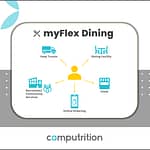Hospital Retail Foodservice: Driving Innovation and Wellness
Hospital foodservice is constantly evolving, and retail dining plays a significant role in that transformation. Today, many hospitals serve more retail meals than patient meals. This shift creates exciting new opportunities for engagement, wellness, and growth.
Staff members work long shifts, and visitors often spend hours or even days on-site. Both groups need quick, nourishing meals without leaving the hospital. That’s where hospital retail foodservice comes in—supporting health, convenience, and connection while generating additional revenue for healthcare organizations.

Technology Drives Modernization
Technology is powering the next wave of hospital retail foodservice innovation. From digital menu boards to self-checkout kiosks, tech solutions simplify operations and improve guest satisfaction.
Digital menu boards capture attention and streamline menu updates. Integrated software supports features like nutrition labeling, loyalty programs, and flexible payment options. Together, these tools enhance efficiency while giving guests the information they need to make smart choices.
Meanwhile, self-checkout and online ordering have become game changers. They reduce wait times and give staff more time to relax during breaks. Sites from health systems like ThedaCare, Intermountain Health, and Harris Health have reported strong adoption and positive feedback.
See self-checkout in action at Intermountain Health!
Sustainability and Community Impact
Beyond technology, hospitals are using retail foodservice programs to promote sustainability and community wellness. Many facilities are composting food waste, maintaining rooftop gardens, and/or sourcing local produce. These efforts not only reduce environmental impact but also build pride among staff and visitors.
Additionally, hospital retail foodservice can help address food insecurity. Programs that provide meals to unhoused or at-risk patients strengthen community ties and demonstrate social responsibility. For sites like Legacy Emanuel Medical Center in Portland, Oregon, these initiatives demonstrate how foodservice can extend care beyond hospital walls.
Turning Data into Better Dining
Modern foodservice isn’t just about great food—it’s about smart decisions. Automation and analytics tools help operators understand buying patterns and customer preferences. With that insight, teams can adjust menus, track performance, and design more appealing offers.
Dynamic displays and targeted promotions further boost engagement. Loyalty and rewards programs encourage repeat visits, while attractive merchandising inspires impulse purchases. Over time, these efforts turn one-time guests into returning customers.
Best Practices for Success
Enticing
Offer delicious in-house items to retain staff and guests on-site.
Nutritious
Highlight healthy meals that align with hospital wellness goals.
Vibrant
Extend variety with inclusive options (e.g., gluten free, vegan, allergy-friendly, halal, kosher). Seasonal menus can showcase local produce and foster a festive atmosphere.
Convenient
Provide grab-and-go stations and quick-service counters for staff on tight schedules.
The Bottom Line
When facilities invest in technology, sustainability, and smart design, they create dining programs that nourish both people and communities. By reimagining retail foodservice, hospitals can strengthen wellness initiatives, enhance satisfaction, and drive revenue—all at once.
Ready to elevate your hospital retail foodservice? Let’s talk about how technology can transform your operations.
Related Posts
Ready to experience our software?
Get a Taste of our Foodservice Software!



